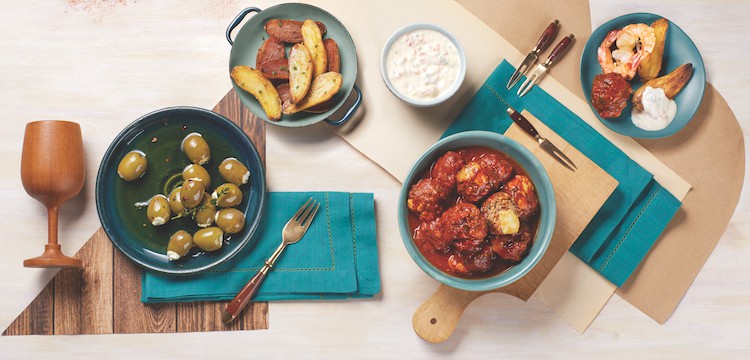
What is a TAPA?
In short, tapas are savory small plates meant to accompany a beverage. They can be enjoyed individually as a bar snack or ordered in great quantities to create a full meal. Ingredients vary by region, but often include meat, cheese, and/or seafood.
Did you know? Tapa is a Spanish noun meaning “cover” or “lid.”It’s unclear exactly how it got its present-day meaning, but tapa is so ingrained in Spanish culture that it spawned two new words: tapear (verb) and tapeo (noun), both essentially meaning “tapas crawl.”
Why are all tapas savory?
For the same reason popcorn and peanuts reign supreme at baseball stadiums: Salt encourages more drinking, and thus puts more money in the pocket of the establishment.
What to pair?
Sip sherry. While Spain is famous for its plethora of wines (ubiquitous tempranillo, spicy Rioja, sparkly Cava, and more), this local aperitif goes especially well with rich, savory tapas. Learn more about sherry, including which varieties to pair with certain cheeses, here.
Legend Has It…

Tapas have several origin myths—here are some of the most popular:
Blame the Kings
- In the 13th century, King Alfonso X of Castile fell ill and found he could eat and drink only in small amounts. After he recovered, he continued his tapas diet, even decreeing that alldrinks should be served with a small snack.
- In the 19th century, King Alfonso XIII stopped in the windy, dusty city of Cádiz for a drink. The thoughtful bartender placed a slice of ham atop his glass to keep windblown debris from sullying the liquid (yum, right?). The king enjoyed this presentation so much that he asked for another, and in doing so kicked off a trend.
Or Resourceful Bartenders
- At a Seville bar popular with farmers, ’tenders served drinks topped with saucers to keep the flies out. (Food was later served on the saucers, presumably once they had their pest problem under control.)
- A group of tavern owners realized that serving strong cheese alongside cheap wine helped mask unpleasant flavors. And, since cheese is salty, the pairing could also spur imbibers to order another round.
Tapas Pantry Staples
Olive Oil
Arguably the most important ingredient in all of Spanish cuisine, olive oil is a must-have for tapas. However, reading labels can be confusing. Short of stopping by your local specialty foods store and asking for their recommended bottle, here’s an easy way to ensure that each glug is great: Always spring for extra-virgin olive oil. The term denotes that the oil was cold-pressed sans chemicals and that it meets certain taste and composition requirements.
Garlic
Garlic lovers, line up (vampires, steer clear)—this allium is all over tapas, whether it’s rubbed on bread, infused in oil, or incorporated into sauce. Usually it’s minced, and if you’re making several tapas, the chore might feel a bit burden-some. Whatever you do, don’t sub in garlic powder, or you’ll miss out on a zesty layer of flavor. Instead, invest in a handy garlic press to do the hard work for you.
Photography by Nina Gallant, Styling by Monica Mariano



